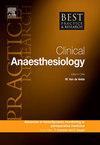Postpartum hemorrhage assessment and targeted treatment
IF 2.8
3区 医学
Q1 ANESTHESIOLOGY
Best Practice & Research-Clinical Anaesthesiology
Pub Date : 2024-09-01
DOI:10.1016/j.bpa.2024.10.004
引用次数: 0
Abstract
Postpartum hemorrhage (PPH) is the leading cause of maternal mortality worldwide, and mitigating it is a global health priority. In this review, we discuss the measurement, assessment, and treatment of PPH. We review different methods of quantifying blood loss, including gravimetry, calibrated drapes and canisters, and colorimetric techniques. Additionally, we highlight the importance of obstetric-specific massive transfusion protocols, point-of-care coagulation testing, and the role of fibrinogen and tranexamic acid. Lastly, we review placenta accreta spectrum management. Anesthesiologists are critical participants in the management of PPH, ultimately influencing patient outcomes.
产后出血评估及针对性治疗
产后出血(PPH)是全世界孕产妇死亡的主要原因,减轻产后出血是全球卫生的优先事项。在这篇综述中,我们讨论了PPH的测量、评估和治疗。我们回顾了不同的定量失血量的方法,包括重量法,校准窗帘和罐,以及比色法技术。此外,我们强调了产科特异性大量输血方案的重要性,护理点凝血试验,以及纤维蛋白原和氨甲环酸的作用。最后,我们回顾了胎盘增生的频谱管理。麻醉师是PPH管理的关键参与者,最终影响患者的预后。
本文章由计算机程序翻译,如有差异,请以英文原文为准。
求助全文
约1分钟内获得全文
求助全文
来源期刊

Best Practice & Research-Clinical Anaesthesiology
ANESTHESIOLOGY-
自引率
0.00%
发文量
37
审稿时长
36 days
 求助内容:
求助内容: 应助结果提醒方式:
应助结果提醒方式:


